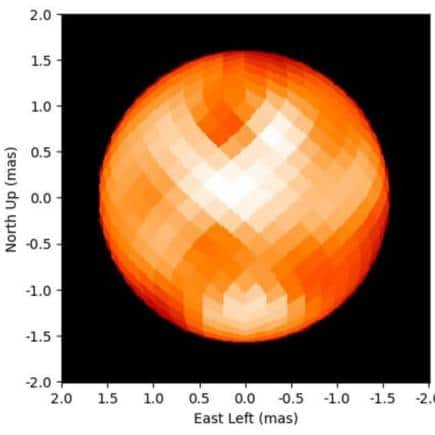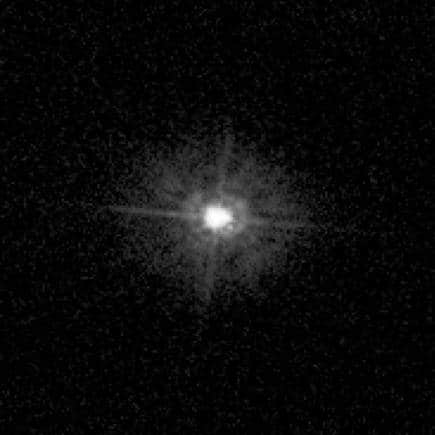For centuries, Polaris, the North Star, has been a beacon for travelers and astronomers, its steady glow providing a reliable reference point in the night sky. However, recent advancements in astronomical imaging have shattered the traditional image of Polaris as a calm and constant star. Scientists, using the CHARA Array at Mount Wilson Observatory in California, have captured high-resolution images of Polaris for the first time, revealing a far more dynamic and complex star than previously imagined.
The Dynamic Surface of Polaris
Long thought to be a smooth and consistent celestial body, Polaris is now known to harbor large, ever-changing spots on its surface. These spots, both bright and dark, bear a striking resemblance to the sunspots observed on our own Sun. This revelation has turned our understanding of Polaris on its head.
The CHARA Array, a powerful network of telescopes working in tandem to create a single, high-resolution lens, has made this discovery possible. Gail Schaefer, director of the CHARA Array, emphasized the significance of this finding: “The CHARA images revealed large bright and dark spots on the surface of Polaris that changed over time.” This discovery suggests that magnetic activity, previously not considered a major factor, could be influencing Polaris’s brightness and behavior in ways that are not yet fully understood.

Rethinking Cepheid Variables
Polaris is not just any star; it belongs to a special class of stars known as Cepheid variables. These stars are renowned for their regular pulsations—expansions and contractions of their outer layers—that cause predictable changes in brightness. Cepheid variables have long been used as cosmic yardsticks, helping astronomers measure vast distances across the universe due to their well-understood relationship between pulsation period and luminosity.
However, the newly discovered surface spots introduce a significant new variable into this equation. Traditionally, a Cepheid star’s brightness was believed to be controlled solely by its pulsation cycles. The discovery of magnetic spots on Polaris suggests that there may be additional factors at play, potentially affecting the accuracy of distance measurements based on Cepheid variables. This finding challenges the existing models of Cepheid variable behavior and suggests that Polaris may be even more complex than previously thought.

Uncovering Polaris's Mass and Complexity
The study also brings new insights into Polaris’s mass and structure. While earlier estimates placed Polaris at several times the mass of our Sun, the latest observations indicate it could be up to five times more massive. This new data suggests that Polaris is more luminous than we previously believed, which could have significant implications for our understanding of Cepheid stars as a whole.
Complicating matters further, Polaris is part of a triple-star system, with a binary companion orbiting it every 30 years. The close orbit and significant difference in brightness between the two stars have made it notoriously difficult for astronomers to study the system in detail. Nancy Evans, an astronomer at the Center for Astrophysics, Harvard & Smithsonian, notes, “The small separation and large contrast in brightness between the two stars makes it extremely challenging to resolve the binary system during their closest approach.”
The discovery of Polaris’s increased mass, combined with the presence of these surface spots, raises new questions about our current models of Cepheid variables. These revelations suggest that we may need to revisit our understanding of these stars and their role in the broader context of stellar evolution.
The Path Forward: Future Research on Polaris
The recent discoveries about Polaris open up exciting new avenues for research. Scientists are eager to continue observing the North Star to better understand the nature of the spots on its surface and their impact on the star’s overall behavior. John Monnier, an astronomy professor at the University of Michigan, shared the team’s plans: “We plan to continue imaging Polaris in the future to better understand the mechanism that generates the spots on its surface.”
These ongoing studies could provide critical insights into the role of magnetic fields in the behavior of Cepheid variables and offer a deeper understanding of the life cycles of stars. By refining our knowledge of stars like Polaris, which serve as cosmic distance markers, astronomers hope to enhance their techniques for measuring the scale of the universe.
As we continue to unravel the mysteries of Polaris, these discoveries may not only deepen our understanding of Cepheid stars but also pave the way for new breakthroughs in the field of astronomy. The North Star, once a symbol of constancy, now represents the ever-evolving nature of our knowledge about the cosmos.
Tags: #Astronomy #Polaris #HighResolutionImages #CepheidVariables #SpaceExploration #StarResearch #MagneticActivity #StellarEvolution

Comments
Post a Comment